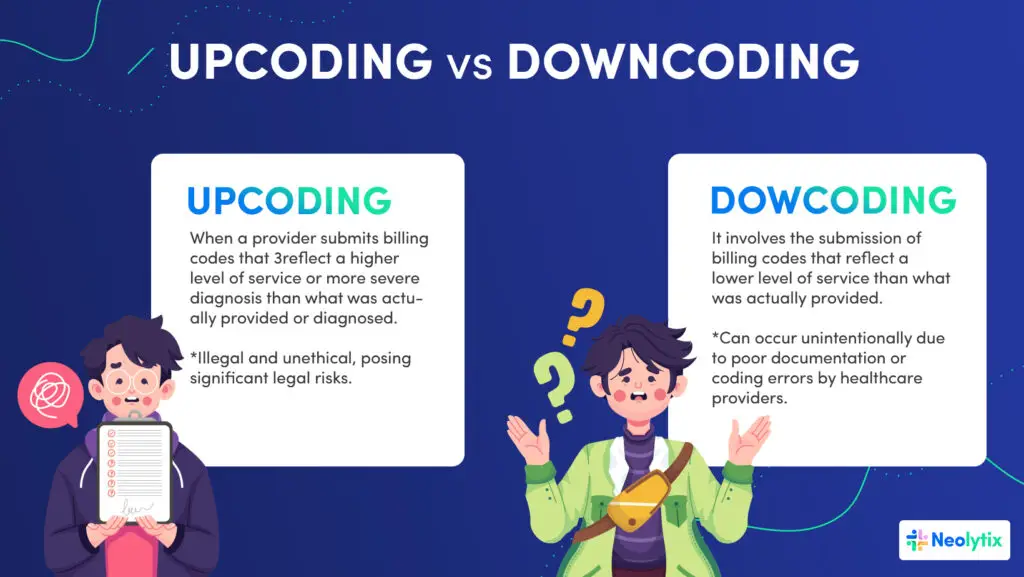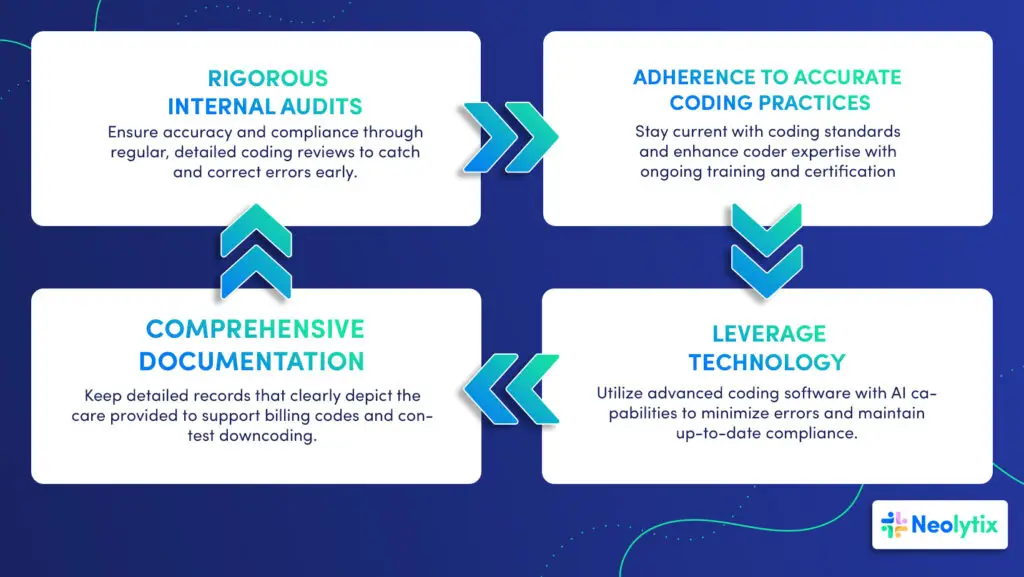Among the variety of challenges faced by healthcare organizations, effective medical billing practices play a pivotal role. Particularly, the problem of downcoding in medical billing emerges as a significant concern that can undermine the financial performance of any healthcare organization.
What Is Downcoding?
Downcoding occurs when insurance payers adjust the billing codes to lower reimbursed rates than deserved, affecting the revenue and operational efficiency of healthcare providers. Understanding and addressing this issue is crucial for maintaining the financial health of healthcare organizations.
To face these challenges effectively, it is vital to develop robust strategies against downcoding. Additionally, partnering with skilled billing experts can play a pivotal role in ensuring accurate billing and maximizing revenue recovery.
What Is the Difference Between Upcoding and Downcoding?
Understanding the distinctions of medical billing codes, particularly the differences between upcoding and downcoding, is crucial for healthcare providers and organizations aiming to ensure accurate billing and compliance.
Upcoding occurs when a provider submits billing codes that reflect a higher level of service or more severe diagnosis than what was actually provided or diagnosed. This practice can lead to higher reimbursements but is illegal and unethical, posing significant legal risks, including fines and sanctions under healthcare fraud statutes.
Conversely, downcoding involves the submission of billing codes that reflect a lower level of service than what was actually provided. While sometimes resulting from payer-initiated reductions to minimize payment, it can also occur unintentionally due to poor documentation or coding errors by healthcare providers.

Unlike upcoding, downcoding leads to lower reimbursements, directly impacting the revenue stream of healthcare practices and potentially affecting the quality of patient care due to perceived financial constraints.
Downcoding can stem from several factors, including automated claim editing software used by insurance companies, which might downgrade codes automatically, often without a thorough review. Payer policies can also enforce stringent requirements that, if not meticulously met, lead to downcoding.
Both practices underscore the importance of accurate coding and documentation. Upcoding risks legal consequences and can damage the trust and integrity of healthcare providers, while downcoding risks financial loss and understates the complexity of patient care, which can influence future care decisions and resource allocation.
Therefore, maintaining precise coding practices not only upholds compliance but also ensures the financial health and sustainability of healthcare organizations.
Legal and Financial Implications of Downcoding
The legal implications of downcoding are profound. While unintentional downcoding poses compliance risks and financial losses, deliberate downcoding by providers to avoid audit risks can lead to severe legal penalties under false claim statutes.
For healthcare organizations, the financial impact extends beyond mere loss of immediate revenue. Downcoding affects the overall reimbursement rates and, by extension, the financial stability of healthcare practices.
This systemic underpayment can compromise the ability to invest in quality patient care and advanced medical technologies.

How to Prevent Downcoding?
Rigorous Internal Audits
To prevent downcoding and ensure billing accuracy, healthcare organizations should implement regular and rigorous internal audits. These coding audits help identify any discrepancies or patterns of downcoding before they impact revenue.
By closely monitoring coding practices and claims submissions, practices can catch errors or misinterpretations early, reducing the risk of lost revenue and ensuring compliance with current coding standards.
Adherence to Accurate Coding Practices
It is crucial for healthcare providers to strictly adhere to accurate coding practices. This involves staying updated with the latest coding guidelines and ensuring that coders are well-trained and certified.
Regular training sessions can help coding staff understand the nuances of new codes and regulations, which in turn minimizes coding errors and protects against revenue losses due to downloading.
Comprehensive Documentation
Maintaining detailed and comprehensive medical records is essential in justifying the codes used for billing. This documentation should clearly reflect the level of care provided, as it serves as the primary defense against downcoding during audits or payer reviews.
By ensuring that all services are fully and accurately documented, healthcare providers can effectively contest downcoded claims and secure the correct reimbursement for the services rendered.
The Power of Technology in Preventing Downcoding
Technology offers robust solutions to the challenges of downcoding in medical billing. Advanced medical coding software now incorporates AI to analyze and suggest accurate coding based on detailed clinical documentation, substantially reducing human errors.
Automated systems also track changes in coding guidelines in real-time, ensuring compliance and accuracy. For example, software solutions like Codify by AAPC allow coders to access the most current information, and tools like Epic Systems’ integrated EHR systems provide real-time alerts to coders about potential downcoding scenarios.
The Benefits of Professional Medical Billing Services
Partnering with professional medical billing services offers transformative benefits for healthcare providers such as:
Optimizing Healthcare Billing Operations
| These services bring specialized expertise that might not be available internally, particularly in handling complex medical coding scenarios that frequently lead to issues like downcoding. Complex cases require nuanced knowledge of the latest coding standards, which professional billers provide, ensuring accuracy and compliance. |
Reducing Operational Burdens | Outsourcing medical billing operations can significantly reduce the administrative load on healthcare providers. By transferring the responsibility of billing and coding to expert partners, medical practices can focus more on patient care rather than the intricacies of billing processes. This shift not only helps reduce internal workload but also streamlines operations, making practices more efficient. |
Improving Revenue and Compliance
| Professional billing services do more than just handle day-to-day billing tasks; they play a crucial role in minimizing billing errors and maximizing revenue. These services ensure that billing is done accurately and compliantly, which reduces the likelihood of rejected or downcoded claims. The expertise of professional billers in navigating the complexities of insurance claims and payer policies means better revenue optimization and improved operational efficiency for healthcare practices. By ensuring that each claim is accurately coded and submitted, they help secure the maximum possible reimbursement for services rendered, boosting the financial health of the practice. |
The challenges of downcoding are significant but not insurmountable. With rigorous internal audits, adherence to accurate coding practices, and the integration of advanced technological solutions, healthcare organizations can protect their revenues and ensure financial stability. The real-world examples discussed underscore the importance of proactive measures and continuous improvement in billing practices.
Take the Next Step Towards Optimizing Your Billing Processes
If downcoding has impacted your practice’s revenue or if you’re seeking to enhance your billing operations, it’s time to consider expert help. With over 12 years of experience, Neolytix offers comprehensive billing and coding solutions tailored to your specific needs, helping you secure maximum reimbursement and financial stability.
Contact Neolytix today for a consultation and begin your journey toward optimized medical billing and improved financial and revenue health.
Don’t let downcoding undermine your practice’s success—act now.
Refine Your Billing Strategy
"*" indicates required fields



